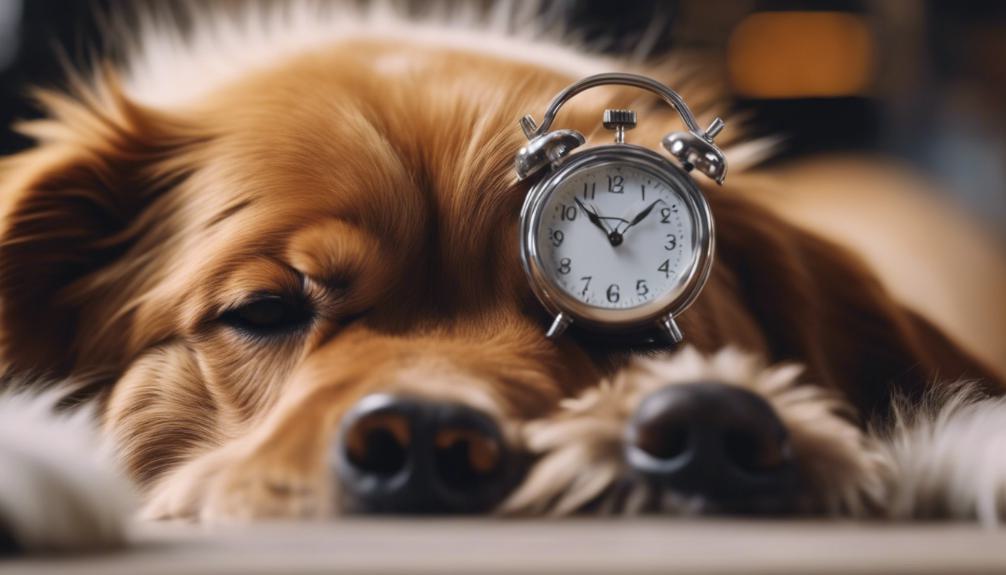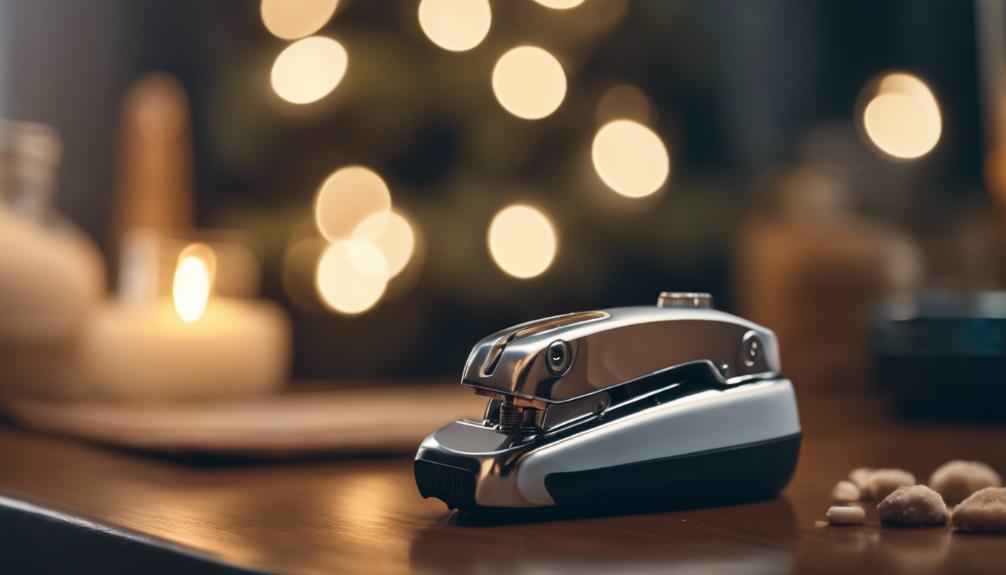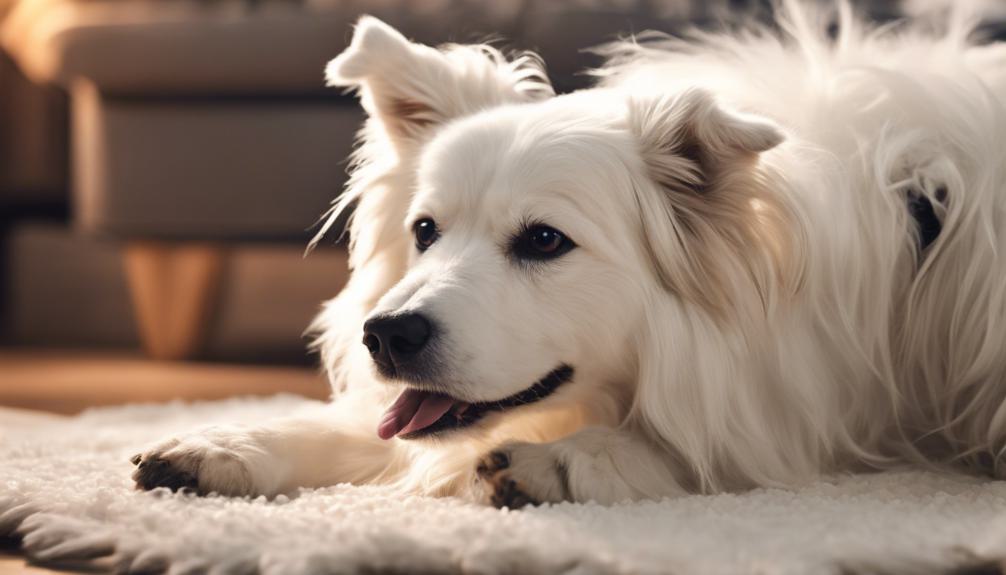How to Trim Uncooperative Dog’s Nails? Success Tips
To trim your uncooperative dog’s nails successfully, start by creating a calm environment with non-slip surfaces and using pleasant scents. Use positive reinforcement like treats and clicker training to encourage good behavior. Give treats strategically during the process, rewarding small advancements. Take breaks to ease tension and build trust. Keep sessions short and positive, focusing on your dog’s comfort. Consider seeking professional help if needed. Stay patient, consistent, and attentive to your furry friend’s cues. By following these tips, you can make nail trimming easier and more manageable. Your pup’s well-being and cooperation are key to achieving nail trimming success.
Setting the Right Environment
Creating a calm and familiar setting is essential for successfully trimming an uncooperative dog’s nails. Choose a quiet area with good lighting to clearly see the nail structure and quick. Opt for non-slip surfaces to prevent your furry friend from slipping and moving around during the nail trimming process. Consider using calming aids like lavender scents or soothing music to help relax your dog.
Having all necessary tools and treats within reach can make the nail trimming experience smoother and maintain your dog’s focus. By setting the right environment for nail trimming, you can reduce stress and distractions, making the process easier for both you and your pet.
Using Positive Reinforcement
When trimming your dog’s nails, remember to:
- Reward them with treats for good behavior
- Use clicker training to mark desired actions
- Stay calm and patient throughout the process
Positive reinforcement can help your dog associate nail trimming with positivity, making the experience more pleasant for them. By consistently using positive reinforcement techniques, you can gradually train your dog to cooperate and feel more comfortable with nail trims.
Reward With Treats
To effectively encourage cooperation and positive associations with nail trimming, reward your uncooperative dog with high-value treats like cooked chicken or cheese. Here’s how to make treat-giving a successful part of your dog nail trim routine:
- Consistent Rewarding: Offer treats consistently throughout the nail trimming process to create a positive association with the activity.
- Reward Progressions: Acknowledge small progressions and calm behavior with treats to motivate your dog to continue cooperating.
- Immediate Reinforcement: Give treats immediately after desired behavior to reinforce good experiences and make nail trimming more enjoyable for your furry friend.
Incorporating these treat-giving strategies as part of your positive reinforcement techniques can help make nail trimming sessions smoother and more successful.
Use Clicker Training
Implement clicker training during nail trimming to reinforce positive behavior and create a cooperative atmosphere for your dog.
Clicker training involves using a clicker to mark desired behaviors during nail trimming, followed by rewarding the dog with treats. The click sound signals to the dog that they’ve performed the desired behavior, leading to increased cooperation.
Positive reinforcement through clicker training helps create a positive association with nail trimming for the dog. It can also aid in gradually desensitizing an uncooperative dog to the nail trimming process.
Consistent use of clicker training can make nail trimming a more pleasant experience for both the dog and the owner. So, grab your clicker, some treats, and get ready to turn nail trimming into a positive and rewarding experience for your furry friend.
Stay Calm and Patient
Remaining calm and patient during the nail trimming process is essential to prevent escalating your dog’s anxiety or fear. Here are some tips to help you stay calm and use positive reinforcement effectively:
- Use treats and praise: Reward your dog for good behavior during the nail trimming process.
- Break it down: Divide the nail trimming into smaller steps to make it more manageable for your dog.
- Stop bleeding: In case you accidentally cut the quick and the nail starts bleeding, remain calm, apply styptic powder, and reassure your dog.
Introducing Treats Strategically
Introducing your dog to high-value treats strategically can greatly improve their cooperation during nail trimming sessions.
In the realm of dog nail care, using treats as a positive reinforcement tool can work wonders.
Reward your furry friend with a tasty treat for each small step of progress during the nail trimming process.
Make sure to pair treat-giving with moments of calmness and cooperation to reinforce the desired behavior effectively.
Choose treats that your dog finds irresistible to boost motivation and engagement.
Consistency is key – by consistently giving treats during nail trimming, you can build trust and cooperation over time, making the whole process much easier for both you and your pup.
Taking Necessary Breaks

Taking breaks during nail trimming is essential to reduce stress and anxiety for both you and your dog. Here are some reasons why incorporating breaks into the nail trimming process is beneficial:
- Relaxation: Pausing allows your dog to relax, preventing the situation from becoming overwhelming during nail trimming.
- Mindset Reset: Breaks provide an opportunity to reset and approach the nail trimming process with a calmer mindset, leading to a more positive experience.
- Building Trust: Utilizing breaks effectively can help build trust and cooperation over time, making future nail trimming sessions more successful.
Making It a Positive Experience
To make nail trimming a positive experience for your dog, focus on using positive reinforcement techniques to create a pleasant association with the process. Reward your furry friend with treats and praise during and after each nail trimming session.
By gradually introducing the tools and process to your dog, you can help establish trust and reduce any fear or resistance they may have. Keep the nail trimming sessions short and frequent to help your dog become more comfortable over time.
Stay patient, calm, and consistent throughout the process to guarantee your dog associates nail trimming with a positive experience. Remember, positive reinforcement goes a long way in making this task easier for both you and your beloved pet.
Seeking Professional Assistance

Seek professional assistance from groomers or veterinarians to expertly trim your uncooperative dog’s nails. Here’s why they can help:
- Skill and Experience: Professional groomers have the expertise to handle tricky nail trimming situations effectively.
- Safety First: They possess the right tools and know-how to guarantee the process is safe for both you and your furry friend.
- Tailored Approach: Professionals can assess your dog’s behavior, recommend suitable techniques, and customize the nail trimming experience to suit your dog’s individual needs.
Relying on professional assistance not only makes the nail trimming process smoother but also prioritizes the well-being and comfort of your pet.
Exploring Alternative Methods
Consider incorporating gentle restraint techniques and a positive reinforcement approach when exploring alternative methods for trimming your uncooperative dog’s nails.
These methods can help create a more relaxed environment for your furry friend, making the nail-trimming experience less stressful.
Gentle Restraint Techniques
When attempting to trim an uncooperative dog’s nails, employing gentle restraint techniques can greatly aid in the process. Here are some helpful tips to assist you:
- Use a calming touch and reassuring voice to soothe the dog during nail clipping.
- Consider wrapping the dog in a towel for added security and comfort while trimming their nails.
- Apply gentle pressure to specific points on the dog’s body to help keep them relaxed and cooperative.
Positive Reinforcement Approach
To effectively implement the positive reinforcement approach for trimming an uncooperative dog’s nails, start by rewarding desirable behavior during the nail clipping process with treats or praise. Positive reinforcement involves creating a positive association with nail trimming by offering rewards when the dog displays calm behavior.
This method helps the dog understand that nail clipping is a positive experience. You can also use distractions like toys or treats to make the process more enjoyable for your furry friend. By slowly desensitizing your dog to nail trimming and focusing on building trust through consistent positive reinforcement, you can help reduce their resistance to the procedure.
Avoid forceful or negative methods, as these can lead to increased anxiety and make nail trimming more challenging for both you and your pet.
Remaining Patient and Consistent

Remaining patient and consistent is essential when dealing with an uncooperative dog during nail trimming. To navigate this challenging task successfully, consider the following tips:
- Stay Calm: Dogs can sense your emotions, so remaining calm can help them relax.
- Use Treats: Rewarding good behavior can encourage cooperation during nail trims.
- Practice Regularly: Consistent practice can help your dog get accustomed to having their nails trimmed.
Understanding Your Dog’s Needs
Comprehending your dog’s needs involves acknowledging their individual comfort levels and anxieties related to nail trimming. Pay close attention to your dog’s behavior in handling their nails. Observe their body language for signs of distress, like pulling away, whimpering, or showing teeth.
Tailor your approach to nail trimming based on your dog’s specific needs and preferences. If your dog has had negative experiences with nail trimming in the past, take note of what triggers their anxiety. Consulting with a professional trainer or behaviorist can provide valuable guidance in grasping and meeting your dog’s needs for successful nail trimming sessions.
Working Towards Success

As you start on the journey of working towards success in trimming your uncooperative dog’s nails, remember the power of positive reinforcement techniques.
To effectively trim your dog’s nails, consider implementing the following strategies:
- Break it Down: Divide the nail trimming process into smaller, manageable steps to help your dog gradually adjust and feel more comfortable.
- Treat Time: Utilize high-value treats or rewards to create a positive association with nail trimming, making it a more pleasant experience for your furry friend.
- Consistency is Key: Practice patience and consistency in your training efforts. Over time, your dog will likely become more at ease with nail trims, creating a better quality of life for both of you.
Frequently Asked Questions
How Do You Cut an Uncooperative Dog’s Big Nails?
When dealing with an uncooperative dog’s big nails, make it a positive experience. Use treats and patience to gradually introduce nail trimming. Seek professional advice if needed. Remember, you can safely trim your dog’s nails with the right approach.
What Can I Give My Dog to Calm Him so I Can Cut His Nails?
To calm your dog for nail trimming, consider using calming aids like natural supplements or prescription medications. Consult with your veterinarian for advice. Create a soothing environment with pheromone products and relaxation techniques. Positive reinforcement training with treats can help too.
How Do You Trick Your Dog Into Letting You Cut Their Nails?
You can try using positive reinforcement and gradual desensitization to help your dog feel more at ease with nail trimming. Patience, consistency, and calmness are key. Seek professional help if needed. Remember, building trust takes time and effort.
How Do I Make Sure My Dog Doesn’t Cut His Nails Too Short?
To guarantee your dog doesn’t cut their nails too short, monitor the quick’s length, use proper tools, trim small bits at a time, have styptic powder ready, and seek guidance if unsure. These steps help prevent injury.
Conclusion
To sum up, effectively trimming an uncooperative dog’s nails requires patience, consistency, and a positive approach. By creating the right environment, using positive reinforcement, and grasping your dog’s needs, you can make nail trimming a positive experience for both you and your furry friend.
Remember to take breaks, introduce treats strategically, and explore alternative methods if needed. With time and practice, you can work towards successfully trimming your dog’s nails with ease.

